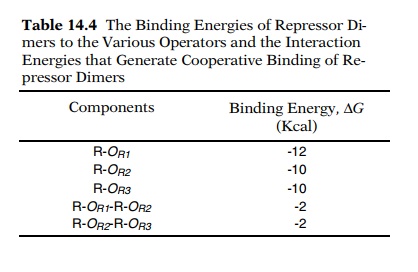Chapter: Genetics and Molecular Biology: Lambda Phage Genes and Regulatory Circuitry
Cooperativity in Repressor Binding and its Measurement
Cooperativity in Repressor Binding and its
Measurement
As seen in the preceding section, repressor does
not bind with equal affinity to the three operators on the right. More detailed
experiments also reveal that repressor molecules do not bind independently to
the
Table
14.4 The Binding Energies of Repressor
Di-mers to the Various Operators and the Interaction Energies that Generate
Cooperative Binding of Re-pressor Dimers

three operators (Table 14.4). Not
surprisingly, repressors bound at the operators interact with one another and
change the overall binding energy of repressor for an operator. Most
unexpectedly, however, the results show that a repressor molecule bound at the
middle operator can interact either with a repressor bound at OR1 or with a repressor bound
at OR3, but it does not
simultaneously interact with both. This is termed a pairwise interaction.
Operator
mutants were used to measure the intrinsic affinity of repressor for the three
operator sites as well as to reveal interactions between adjacently bound
repressor molecules. By eliminating re-pressor binding to OR2, the binding energy of repressor to OR1 and to OR3could be measured without
complications caused by interactionswith adjacent repressors. Similarly,
eliminating binding at OR1
or OR3 permitted
determination of the other binding energies. Ultimately, this series of
measurements provided enough data to permit calculation of the interaction
energies of adjacent repressor molecules. The measure-ments showed that
repressor binding at OR2
has a dramatic effect on the binding of adjacent repressors.
Related Topics